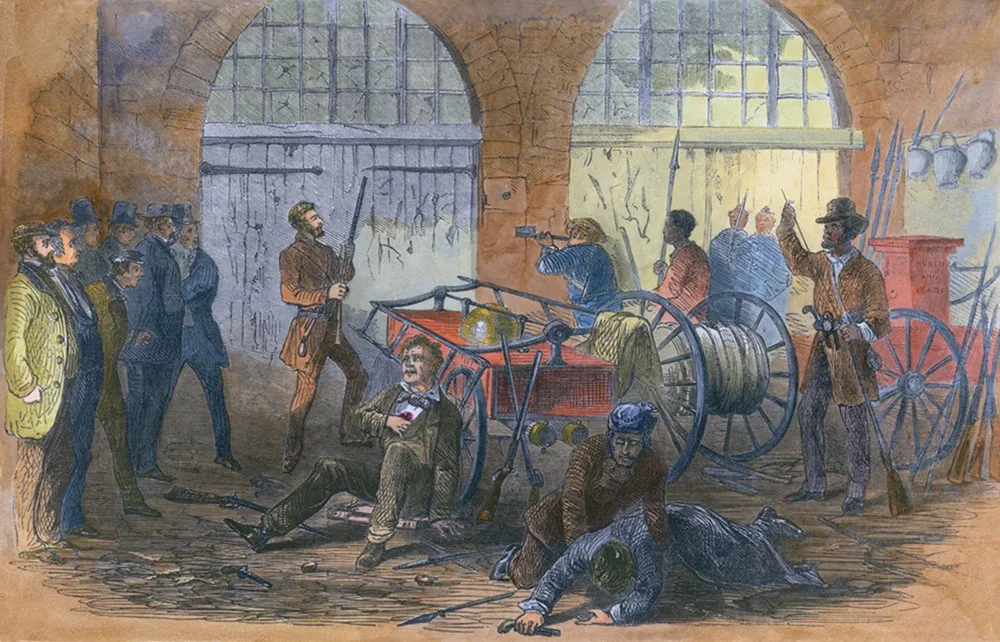APUSH Unit 5
1/29
Earn XP
Description and Tags
1848-1877
Name | Mastery | Learn | Test | Matching | Spaced |
|---|
No study sessions yet.
30 Terms
What were reasons for westward migration (3)? What was the significance of the Oregon Trail? Where did it stretch from? What was the demographic of most pioneers? Role of women? How dangerous was it?
Americans travelled on overland trails to west because of gold rush, panic of 1837, and religious freedom for Mormons
Most Travelled route was Oregon Trail, from St. Louis near Missouri River across Rockies to Oregon Territory. By 1860, 350,000 Americans went on 3-6 month journey to claim lands west
Enabled one of largest migrations in american history
Facilitated westward expansion
Most pioneers were middle class family units and many were male farmers
Many women could take on traditionally male jobs on trail
Travelled in wagon trails to shoulder labor and maintain safety
1/10 of pioneers died heading west looking for opportunity
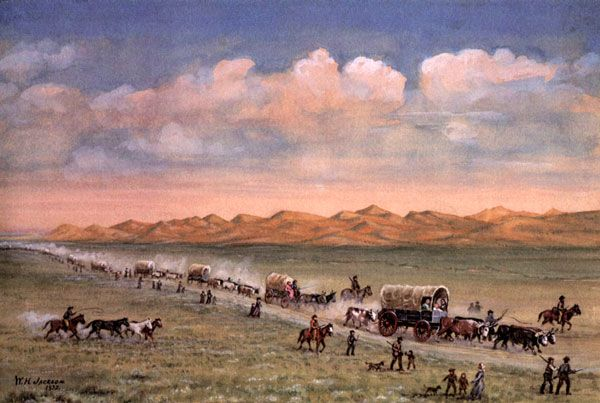
Who were Californios?
original Spanish or Mexican landholders of California.
Prior to 1848, when California became a US state, these Californios made up California’s economic and political elite ranchers.
They held on to their distinct Spanish and Mexican culture, including their Spanish language and Catholic faith.
What started the California Gold Rush? Who were forty niners? How did conflict come between the miners, natives, Californios, and foreign miners? How did the cost of living change? How did this affect California?
Prior to 1848, only a few Americans settled in CA. Discovery of gold at Sutter’s Mill was catalyst to California Gold Rush of 1849
Tens of thousands of “forty-niners” from the east, South America, Europe, and Asia flocked to CA in hopes of striking it rich. These prospectors came into conflict with natives, Californios, and foreign miners
Took property and land without regard for its ownership and destroyed local environment
Exploited Mexicans, natives, and women for labor, food, shelter
Discriminated against Chinese and Latin American immigrants
Due to high demand for goods and services, cost of living skyrocketed and inflation ran rampant
Population boom of diverse peoples = California statehood in 1850
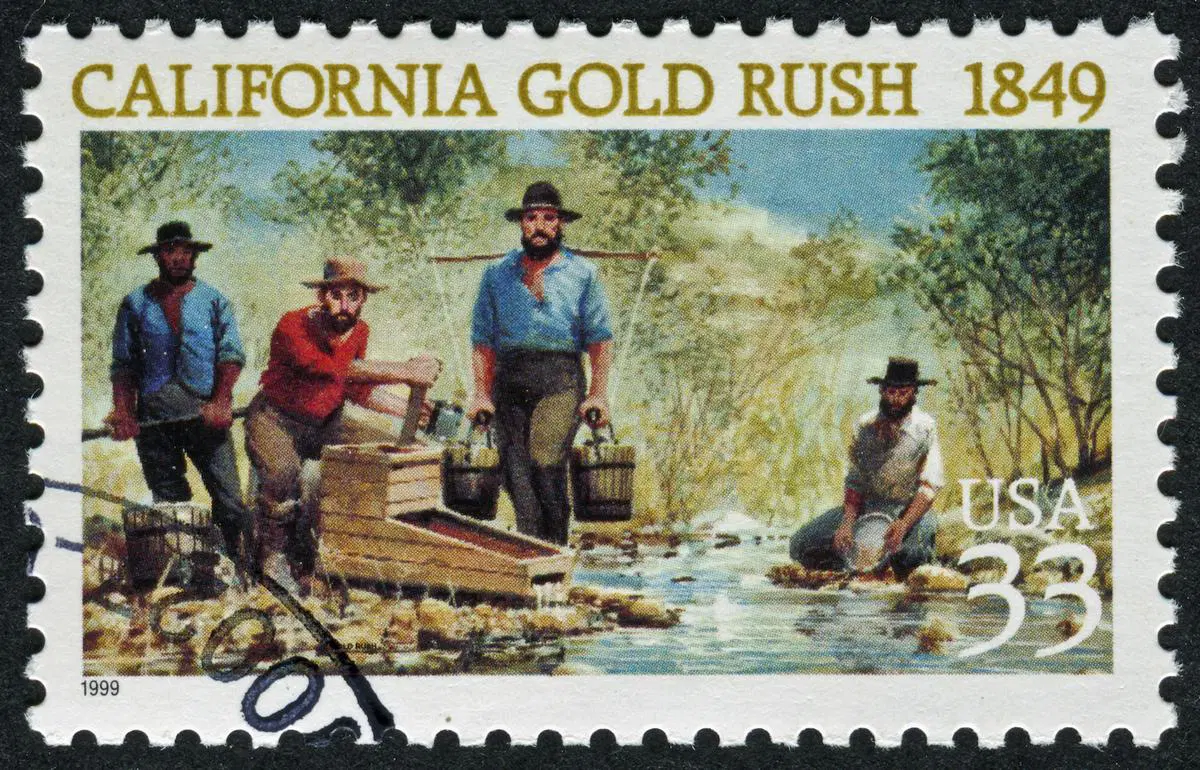
What is James K. Polk’s nickname? How was he significant during the election of 1844? What is Manifest Destiny and what did it cause? What were his campaign promises regarding 3 states and what was his slogan? What were his other promises regarding the economy and presidential term?
11th president. Congressional backer of Jackson = Young Hickory
Election of 1844: 1st dark horse candidate (not even considered presidential candidate when democrats met for convention)
Polk’s Campaign Promises
Manifest Destiny- belief that US was divinely driven to expand west and rule from sea to shining sea. Represented Polk’s presidency and prevailing attitude in America. Creation of national identity Justified and fueled US territorial and cultural expansion across North America
Slogan- “Fifty-four Forty or fight” (currently jointly occupied with Britain. Wanted to claim entire oregon territory up to 54 40 line)
Annexation of Texas
Purchase of California
Other promises-
Independent treasury system
lower tariff
Only one term
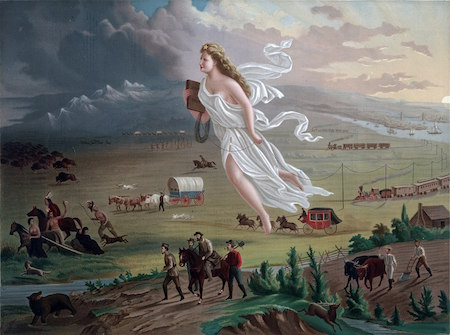
What were James K Polk’s domestic policies to fulfill his campaign promises? What happened with tariffs? What was the treasury and how was it different from the bank of US?
Democratic Domestic policies
Walker Tariff of 1846- significantly reduced tariff rates for imports
Independent Treasury Act of 1846- required US funds be stored in treasuries independent of private banks.
All debts paid in hard currency or Federal Treasury notes
NOT for profit unlike bank of us
What was James K Polk’s foreign policy to fulfill his campaign promises? Who actually took Texas? Why was Oregon significant in how US dealt with war with Britain instead of war with Mexico?
John Tyler annexed Texas before his term ended (Polk’s idea 1st). Border disputes with Mexico remained
Oregon Treaty of 1846 (compromise. Didn’t actually fight Britain)- fixed current border with Canada at 49th parallel. Split territory
Highlights how Polk was willing to settle diplomatic solution with Britain while simultaneously behaving aggressively in Mexican-American War
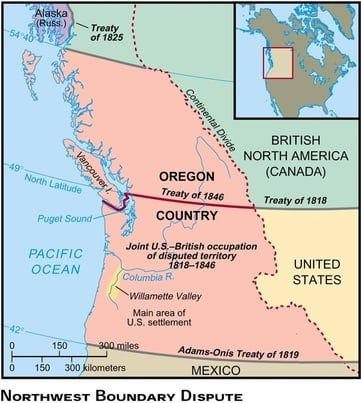
How did the Mexican American War start? What did Slidell try to do with Mexico and why was he rejected? What were the causes? Why was Mexican control weakened in northern Mexico? Role of Rio Grande and Nueces River? Who was attacked by Mexico?
Expansionist agenda
In 1845, Polk sent Slidell to Mexico with $ to Buy CA. Rejected because of resentment after John C. Fremont, Kit Carson, and Ap Catsby Jones (navy already invaded Monterey and captured CA like Andrew Jackson captured Florida) already went through CA)
Since Mexico said no to California, US used border dispute to start war (caused by both CA and border dispute)
Comanche Indian raids in Texas and Comanche’s trade relations with New Mexico decreased Mexican control over northern areas already
Border dispute between Texas/Mexico- border at Rio grande (us want southern border) or Nueces River (Mexico want)
Polk sent Zachary Taylor and US army into disputed territory near Rio Grande
WHen Mexico attacked, Polk demanded declaration of war
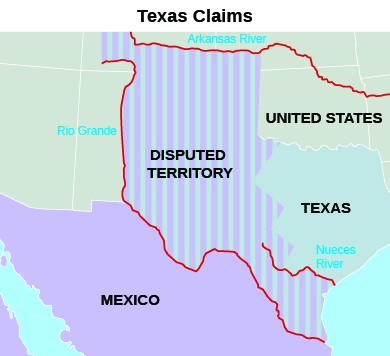
What was the difference between Polk’s reasons for war and Abraham Lincoln’s objection to that war?
Polk- war with Mexico was justified because of Mexican offenses against American sovereignty and security
Troops along disputed area in Texas were necessary to defend American territory
Polk- blames Mexico for being the aggressors and attacking US troops on American soil.
Mexico had wronged US citizens for years already by failing to enforce treaties.
Whig Congressman Lincoln
Calls for Polk to prove that American blood had been shed on American soil, implying war was an unjust and immoral tool to expand into land rightfully owned by Mexico
Disputed territory had been settled by Mexicans for years before Texas Rev and never participated in political process of Texas and US
president sent armed US soldiers to provoke war, since they weren’t “citizens” whose blood was spilled as the president claimed
Why is Senator Thomas Hart Benton significant alongside Polk? Who were the two important generals during the meixcan-American War (one at palo alto/buena vista and one at vera cruz to the capital)?
Senator Thomas Hart Benton- Manifest Destiny senator. Called for westward expansion! (senator of missouri, starting point towards west)
General Zachary Taylor won major victories at Palo Alto/Buena Vista
General Winfield Scott led 2nd US army from Vera Cruz to capture Mexico City
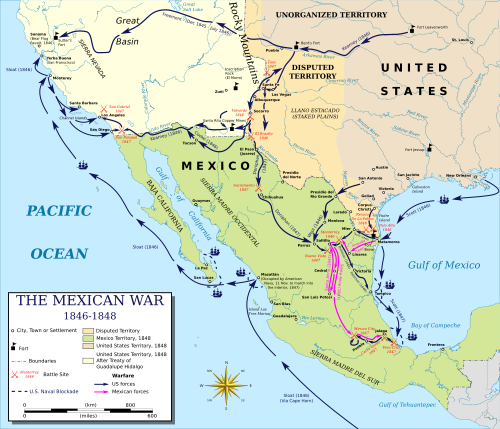
What were three reasons why the US didn’t take all of Mexico after Mexican American war?
Once capital was taken, could’ve taken Mexico but didn’t because…
slavery issue of expansion
Anti-catholic
Racism towards mestizos
What war did the Treaty of Guadalupe-Hidalgo end? What border was fixed? What territory did the US gain? What did the US promise to do and how did they break this due to a discovery in California? Why did Polk end up ratifying it even though he hated it?
Treaty of Guadalupe-Hidalgo- negotiated by Nicholas Trist to end Mexican-American war in 1848
Border fixed at Rio Grande
Mexican cession of CA, texas, and New Mexico territories
US promised to protect Mexicans, their customs, and property in these new territories. Ignored during Gold Rush
Paid 15 million for territories and 3 million in claims owed by Mexican government to US citizens
Polk hated it but ratified after rumors of gold in CA
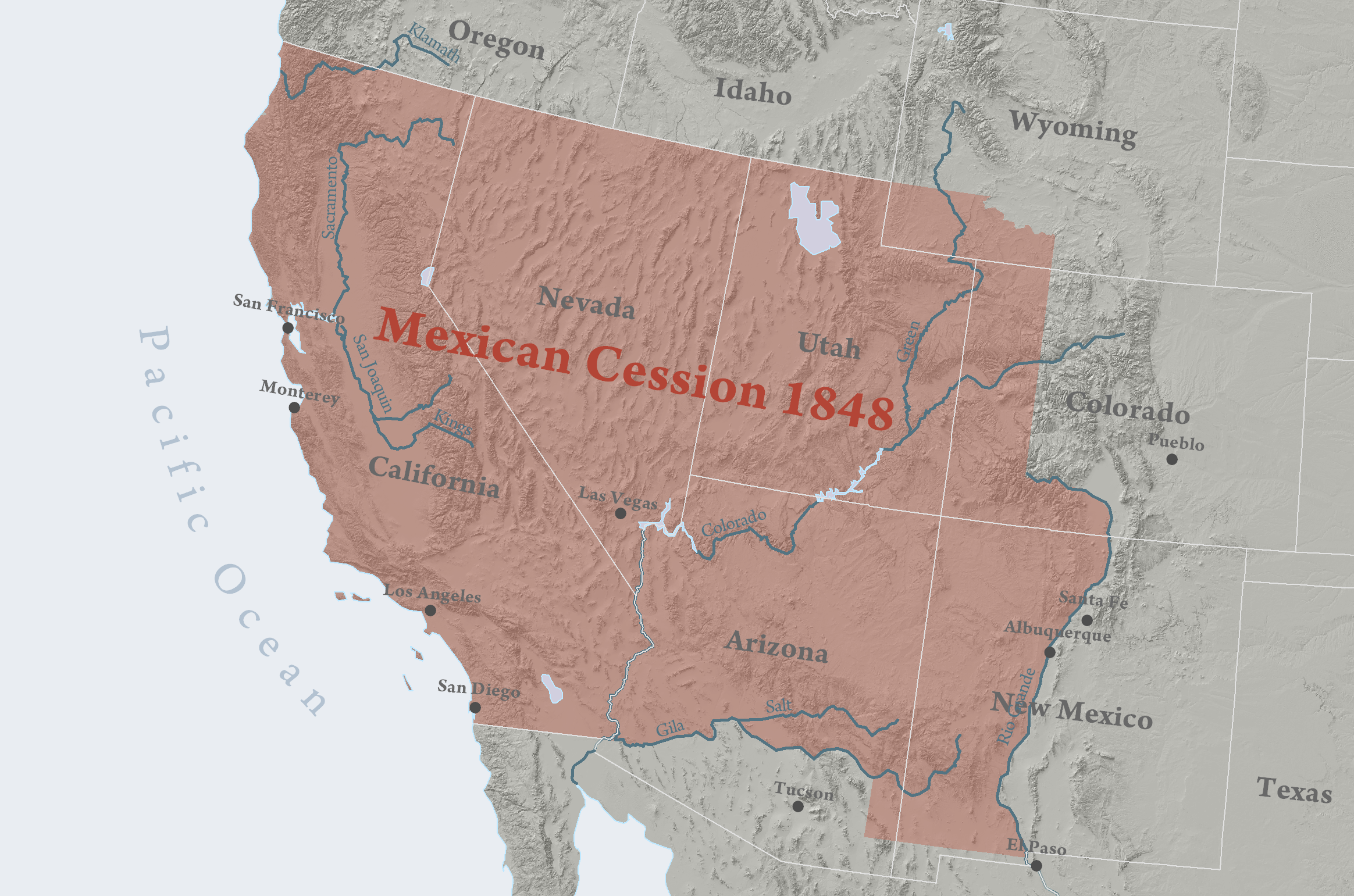
What was the Wilmot Proviso? Why did it fail in the Senate? What political party did it lead to?
Proposed amendment in 1846 that would’ve banned slavery in western territories acquired after Mexican-American war
Failed Senate from southern Democrat opposition (some northern democrats also would rather keep national party together by appealing to south instead of being concerned over the moral issue of slavery)
Intensified sectional tensions, represented interests of northern antislavery advocates, led to Free-Soil Party
What was the Know Nothing Party and the Free-Soil Party? Why did the know nothing party grow? Who were they made up of? What were they against? How did they advocate for workers’ rights? What party grew into the Free Soil Party, what were they inspired by, who made up the Free Soil party and why did they care about slavery?
1844-1860 “Know-Nothing” Party (Northeast)
Emerged in the apparent weakness of democrat and whig parties
Native workers and Protestant farmers
Nativist (prioritized native interests over immigrants’ expanding cultural and political influence)
Anti immigrant anti Catholic American Party
Hated Irish and Irish Potato famine
Advocated for workers’ rights as business owners were believed to favor immigrant workers that could labor for low wages
1848-1860 “Free Soil” Party
Liberty party became Free-Soil party
Based on Wilmot proviso
No slavery
Give away western land for free so poor people without slaves move in, preventing competition from large, wealthy slave plantations
Small farmers and urban workers who weren’t necessarily concerned about ethics of slavery. Instead, worried that expanding slavery into west would economically harm them and destroy republican ideal of society of free farmers.
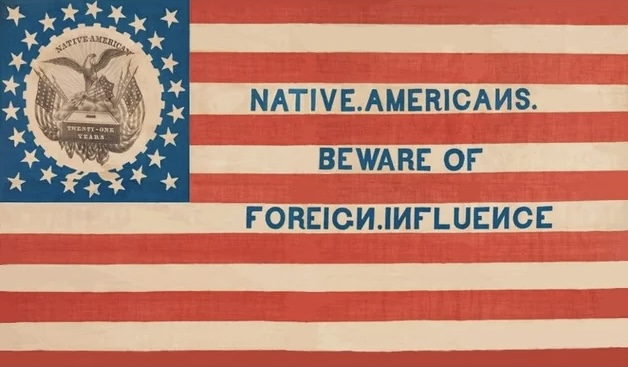
What was the idea of Popular sovereignty by Lewis Cass? What was the goal for the democrat party and what did it say? Was it successful?
For the election of 1848, democrats nominated Lewis Cass.
Popular sovereignty
Tool to keep the Democrat Party together and appeal to northern antislavery supporters
Called upon residents of each territory to independently choose whether they would be free or slave
Temporary solution to question of slavery that proved unsatisfactory to everyone
What was the election of 1848 like? What party emerged and what members did it consist of? What kind of president was Zachary Taylor and what did he believe about CA and slavery, even though he was a southerner?
Emergence of free soil party made of “barn-burner democrats” and “conscience whigs.” Left mainstream parties. Believed in antislavery
Zachary Taylor (last chance to stop Civil War) wanted to make CA a free state and thought South used slavery as a political crutch
What was the Compromise of 1850? What were concessions for the north vs the south? Who did it ultimately benefit and was it successful? What did it settle for Texas and New Mexico? What was the role of the 7th of March Speech? What happened to Zachary Taylor and what did Millard Fillmore do?
Amidst continuous sectional tensions between the North and the South
Henry Clay
North Concessions
CA admitted as free state
Slave trade (not slavery) was abolished in Washington DC
South Concessions
2 new territories created which will use popular sovereignty (people in territories decide slave status)- Utah and New Mexico
Stricter Fugitive Slave Law (no warrant/trial needed)
Texas and Mexico
Settled boundary between them
Since it was more favorable to New Mexico, national government agreed to take Texas’ debts from its time as independent republic during Mexican-American war
Ultimately benefited North (Utah/New Mexico free) but was unsatisfactory to all = Civil War
7th of March speech by Daniel Webster- if we are country of laws, North should support Fugitive Slave Law until slavery outlawed (convinced northern congressman to vote for clay’s compromise to preserve union)
Zachary Taylor wanted to veto compromise = assassination?
Death bed president Millard Fillmore signed
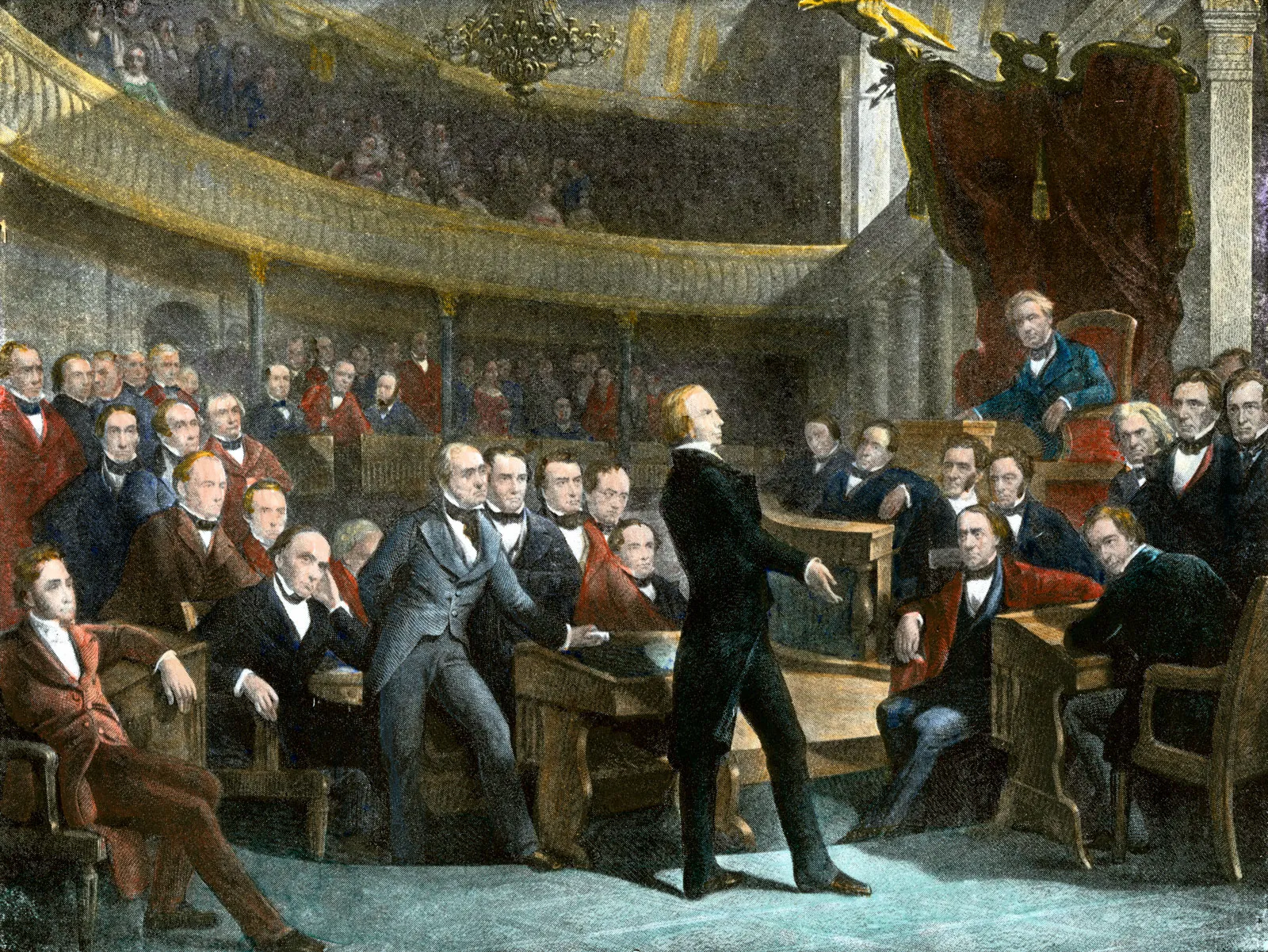
What was the Fugitive Slave Act of 1850? How did it differ from previous fugitive slave laws? How did it take away a fair trial for runaways? What happened as a result?
Earlier fugitive slave laws only required states to help return runaway slaves
As part of Compromise of 1850, Fugitive Slave Act of 1850 made laws stricter
Required individual northern citizens, not just state officials, to help catch slaves, threatening high fines and jail time.
Revoked fair trial for runaways- took away right to jury trials, stopped accused from testifying for themselves, paid commissioners more money for sending slave back to south than freeing
Backlash in North. Abolition movement grew steam as number of enslavers and slave catchers increased
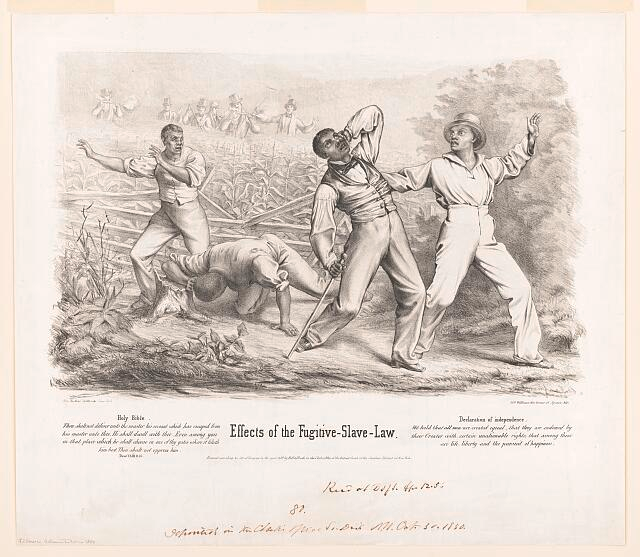
What was the Underground Railroad and why did it grow? Who served as conductors and what did they help slaves with? What was the goal of runaways? Role of Harriet Tubman? What happened to Mary and Emily Edmonson?
After Fugitive Slave Act of 1850, growth in enslavers and slave catchers = expansion of Underground Railroad.
Secret network of routes and safe houses that stretched from southern slave-holding plantations to northern free states and Canada
Northern abolitionists, including free African Americans, Quakers, Baptists, and Methodists, served as conductors on the Underground Railroad
hiding spots, transportation, food, and supplies to slaves
Thousands used the Underground Railroad to flee to Canada or blend into free Black communities
Harriet Tubman, a former slave, returned to free many other slaves.
Purchased the freedom of slaves such as Mary and Emily Edmonson.
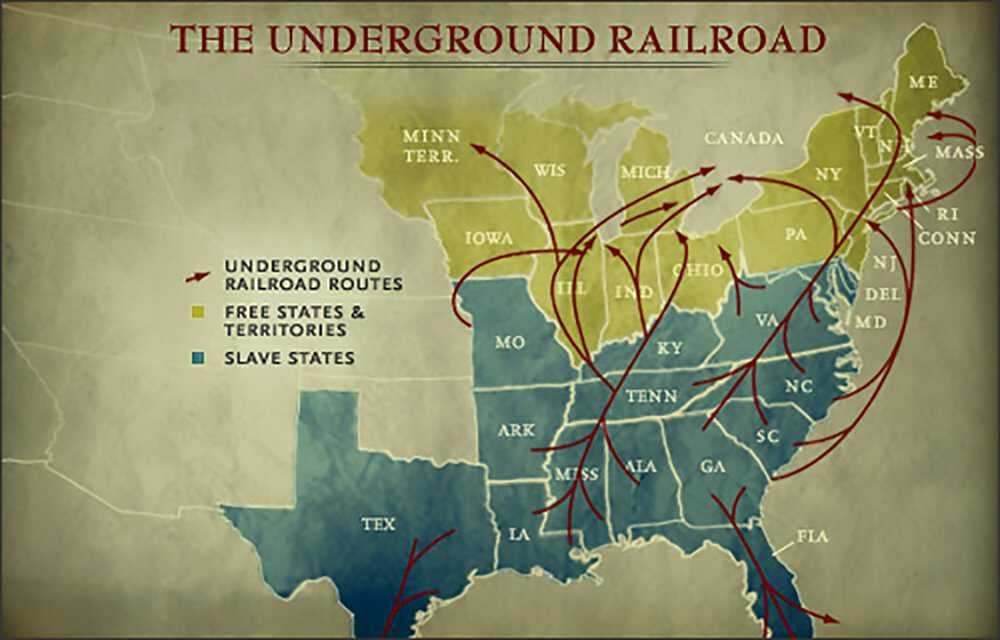
What were personal liberty laws in the 1820s-1850s? How was this a states rights issue?
Northern states refused to help catch fugitive slaves and enforce the Fugitive Slave Law. Ultimately these laws were repealed.
i.e. Personal liberty of Northerners to leave barn door open. It is not their fault if slaves come in to stay.
What was the Ostend Manifesto? What did some Democrats want for Manifest Destiny? What letter was written to Franklin Pierce? After it was leaked to the press, what was the Northern response?
Within the Democratic Party, some people wanted manifest destiny to be extended southward too
U.S. ambassadors and the secretary of state wrote a letter to President Franklin Pierce in 1854, urging him to either purchase Cuba from Spain or conquer Cuba if Spain refused
After it was leaked to the press, the North was upset that the South was making a “dirty plot” to expand slave territories.
Forced Pierce to give up on his expansionist dreams in Cuba
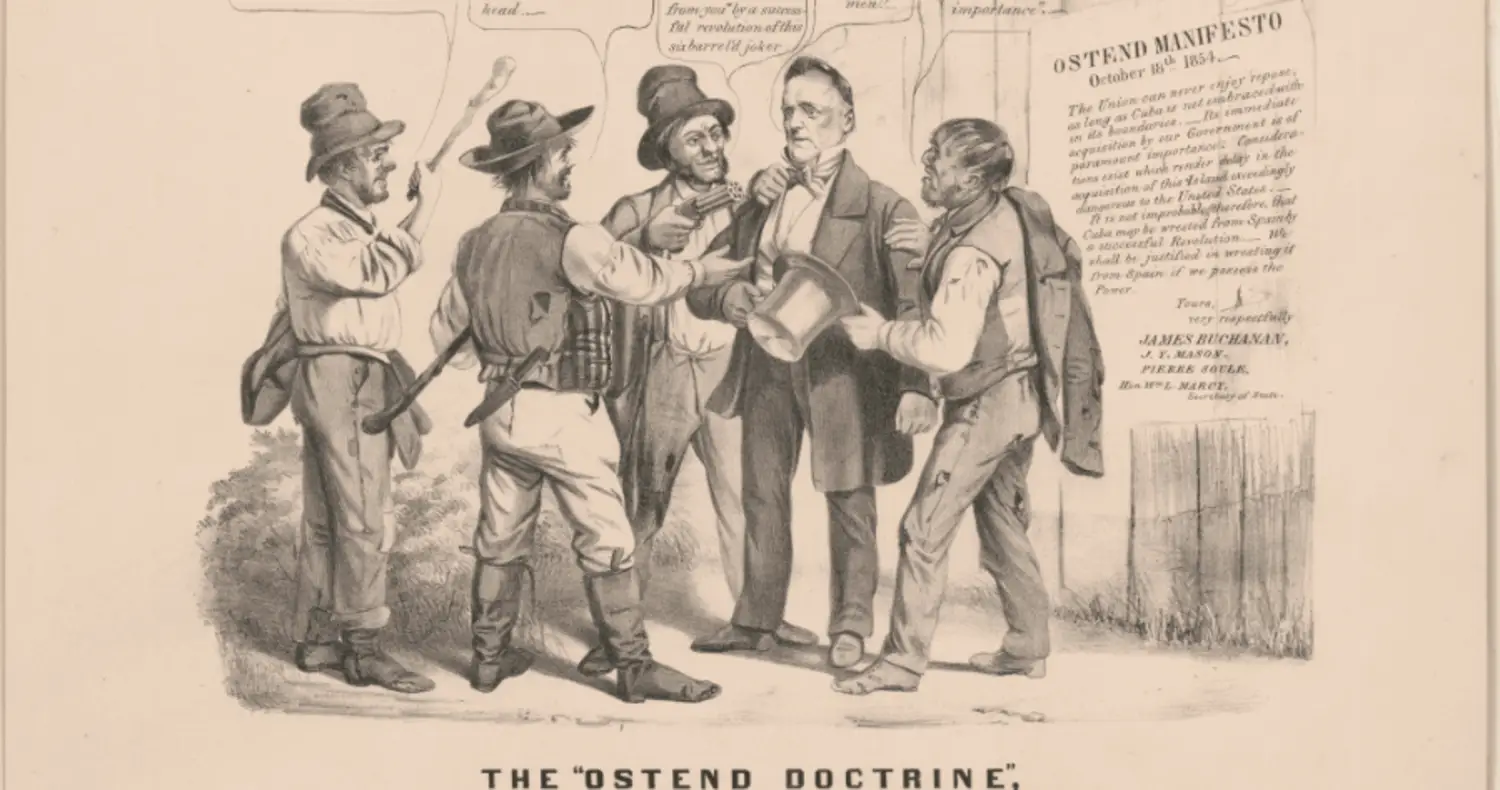
Who were the Compromise Generation and what happened after they died? Who were they replaced with? What was the Do-Nothing Trio and why were they named that? Millard Fillmore, Franklin Pierce, and James Buchanan? What was Buchanan’s famous quote and what was his nickname?
Political giants of era (Compromise Generation) died: Jackson, John Q Adams, Calhoun, Clay, Webster = no chance of compromise in the 1850s as they were replaced by strong pro-south and pro-north politicians
Do Nothing Trio: presidents who took no strong stance on slavery
Millard Fillmore (Compromise of 1850)
Franklin Pierce (Gadsden Purchase)
James Buchanan “I would rather do nothing than to do something wrong.” Did nothing while South seceded. “Old Doughface” (northerner with southern sympathies)
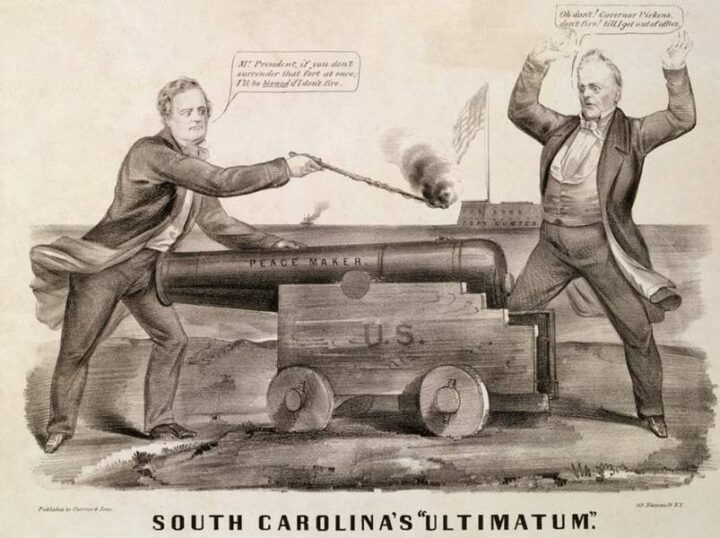
What was the treaty of Wanghia, treaty of tianjin (tsientsin), and treaty of kanagawa? How are they significant in relations between US and Asia and what wars caused them?
Treaty of Wanghia- John Tyler. Opium wars. Protect US missionaries. Diplomatic relations
Treaty of Tianjin- Second Opium War. Legalized opium trade, including for US. Received same concessions as England
Treaty of Kanagawa- Forced Japan to open ports to US trade.
Who wrote Uncle Tom’s Cabin and what was it in response to? How was it significant and what was the response to it? Lincoln’s quote?
Uncle Tom’s Cabin
Harriet Beecher Stowe 1850s. Sold 100,000 copies in first year. Fictional account in response to Fugitive Slave Act that humanized slaves and increased abolitionists. Outraged south
“So you’re the little lady who started the Civil War”
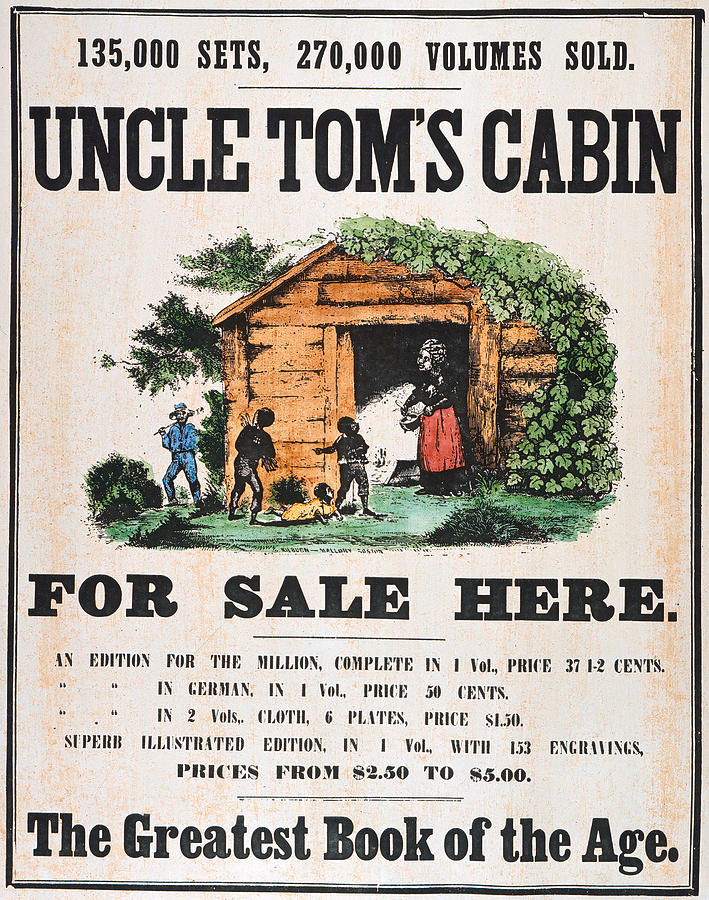
What was the Transcontinental Railroad and what did it facilitate for American expansion? What did it symbolize? What was its role with Stephen Douglas of Illinois in the Kansas-Nebraska Act? What did Douglas want for the Nebraska Territory? How did he appeal to the south? What act did the Kansas and Nebraska act repeal and what treaties were voided? How did Douglas try to compromise to avoid sectional tesions? Why were Whigs and northern democrats angry and what political party died as a result?
Transcontinental Railroad- 1869. Railroad connected east and west. Facilitated mass migration, linked national economy, symbolized American industrialization and economic growth
Democratic senator Stephen Douglas of Illinois wanted Transcontinental Railroad to cross through his state
Nebraska Territory would have to be created out of unorganized region in Northwest, where many natives had settled after forcible displacement
To appeal to south, who wanted railroad to go through south instead, Douglas offered to bring back question of slavery in new territories after Missouri Compromise had already banned it in territories north of boundary
Kansas-Nebraska Act
Repealed Missouri Compromise and created Kansas and Nebraska out of American Indian land, voiding their previous treaty rights to that region
Each territory would decide question of slavery by popular sovereignty = way to keep democratic party together
Most whigs and northern democrats were outraged because they felt missouri compromise line was sacred
Led to end of whigs
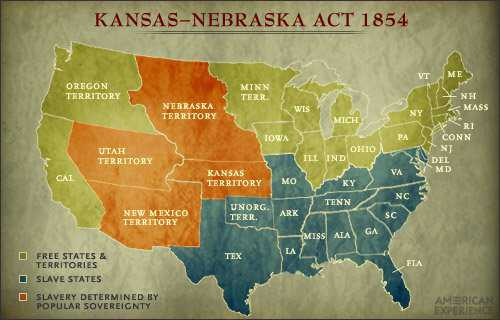
How did the Republican Party form? What was the political party landscape like? Who made up the Republican Party? How was it different from the Whigs? What was their most important member? What three things did they mainly support? How did it appeal to more people than the Whigs? What did the growth of the Republican Party end and what political party died?
With growth of American Party and weakness of Whig and Democrat parties, Republican party formed in 1854 by Free soilers, antislavery “Conscience” whigs, and northern democrats after Kansas-Nebraska Act
Unlike National Whigs, they were strictly rooted in the North (less sectional tension)
One of their most significant members was former Whig Abraham Lincoln
Focused on ending expansion of slavery into new territories, supported economic developments and internal improvements
Appealed to both northern abolitionists and free-soilers who wanted to keep western territory free of competition from blacks
Rise and success = end of Second Party System and final blow to sectionally-fractured Whigs
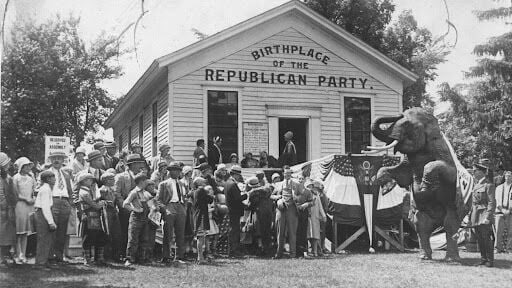
What was Bleeding Kansas after the Kansas-Nebraska Act? Why was referendum rigged and who were “border ruffians”? What two governments were set up and what was the Sack of Lawrence? What did eastern abolitionists do? Who was John Brown and what was the Pottawatomie Massacre?What did the Lecompton Constitution do?
After Kansas-Nebraska Act, Kansas set up referendum to decide question of slavery
Struggle to decide who was eligible to vote. Illegal voters from Missouri known as “border ruffians” and northerners poured into Kansas to influence vote. Rigged election to create proslavery gov, even though majority of residents were free soilers
Two rival governments set up: proslavery at Shawnee Mission and antislavery in Lawrence
Better armed proslavery southerners attacked during Sack of Lawrence
Provoked eastern abolitionists to sneak rifles in- Beecher’s Bibles were guns and ammunition disguised as bibles that were snuck into Kansas
Abolitionist John Brown led Pottawatomie Massacre of proslavery settlers
After government tried to make Kansas a slave state with Lecompton Constitution, violent conflicts and gang violence over slavery in Kansas = deaths of 50 in 1856 and continued until Civil War. Ultimately Kansas became free
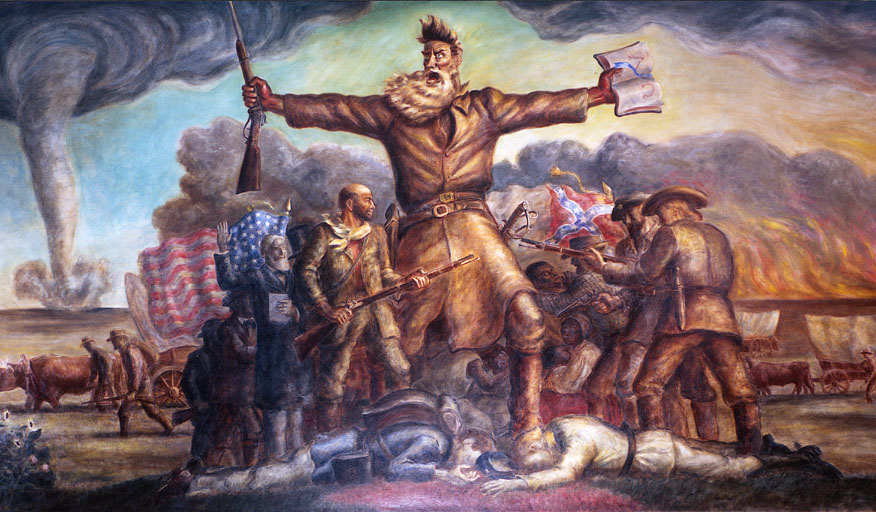
What was the Bloody Shirt incident in 1856 in Congress? Role of Charles Sumner and Preston Brooks? Reaction by both parties?
Bloody Shirt 1856
Senator Charles Sumner from Massachusetts gave speech about evils of slavery and called out Preston Brooks’ family from South Carolina as one of the evil plantation owners
Preston Brooks beat Charles Sumner with cane to defend family. Long recovery
Democrats sent Brooks canes as thanks
Republicans used “bloody shirt” as political symbol against evil Democrats
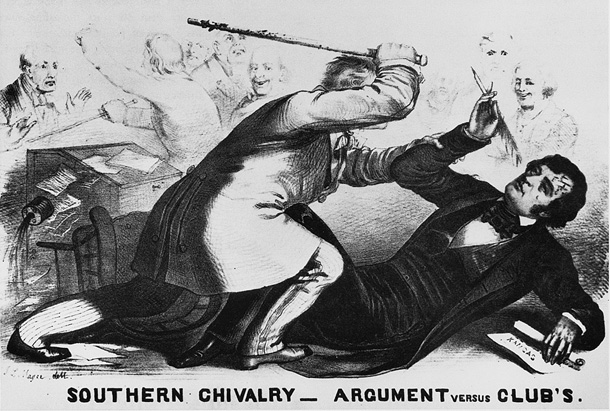
What was Dred Scott v Sanford? Who was Dred Scott and why did he believe it was his right to freedom? In the 1857 Supreme Court Ruling, what did Chief Justice Roger Taney decide for Scott? What did he affirm for slave rights? What was declared unconstitutional? Effect on Republican Party?
Dred Scott was a slave who sued for his freedom, believing it was his right because he had lived with his enslaver in free territories
Dred Scott Case
Chief Justice Taney, southerner, affirmed that slave was NOT a citizen and did not have any rights = Scott wasn’t allowed to sue and Scott and his family continued to be slaves
Missouri Compromise and earlier Northwest Ordinance were unconstitutional and all future Congressional attempts to restrict expansion of slavery into territories was prohibited because Congress had no power to stop slavery from expanding
One of worst supreme court decisions in history. Escalated sectional tensions
Helped Republican Party grow and led to Lincoln’s election
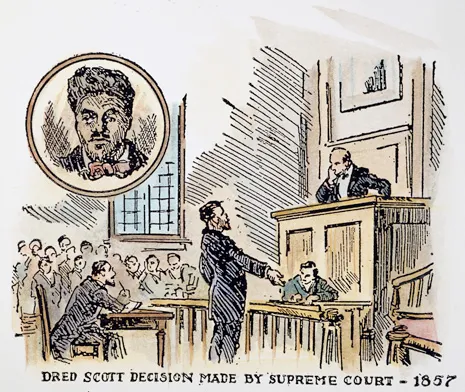
What were the Lincoln-Douglas Debates? What was the context of these debates? How did Lincoln question Douglas’s hypocrisy? What was Douglas’s Freeport Doctrine and how did it hurt the Democrats? what did Douglas accuse Lincoln of regarding the blacks and how did lincoln respond? What did Lincoln warn against? Who won the battle but who won the war?
1859 Illinois Senate Race featured debates between Republican Lincoln and Democrat Stephen Douglas regarding expansion of slavery in territories
Lincoln questioned Douglas’s hypocrisy in supporting both popular sovereignty, which protected right of territory’s inhabitants to ban slavery, and Dred Scott ruling, which protected slavery in all territories
Douglas responded with “Freeport Doctrine” that a territory could still prohibit slavery by refusing to enact laws to protect it
Stance divided Democrat party as Southern Democrats opposed doctrine as betrayal
Douglas accused Lincoln of believing in “Negro equality.”
Lincoln argued that he did not support political or social equality for African Americans and cautioned that the proslavery Supreme Court could make it unconstitutional for states to ban slavery in future
He also advised that a “house divided” government could not be stable and last permanently as half free and half slave
Even though Douglas ultimately won the Senate seat again, Lincoln became nationally recognized political figure
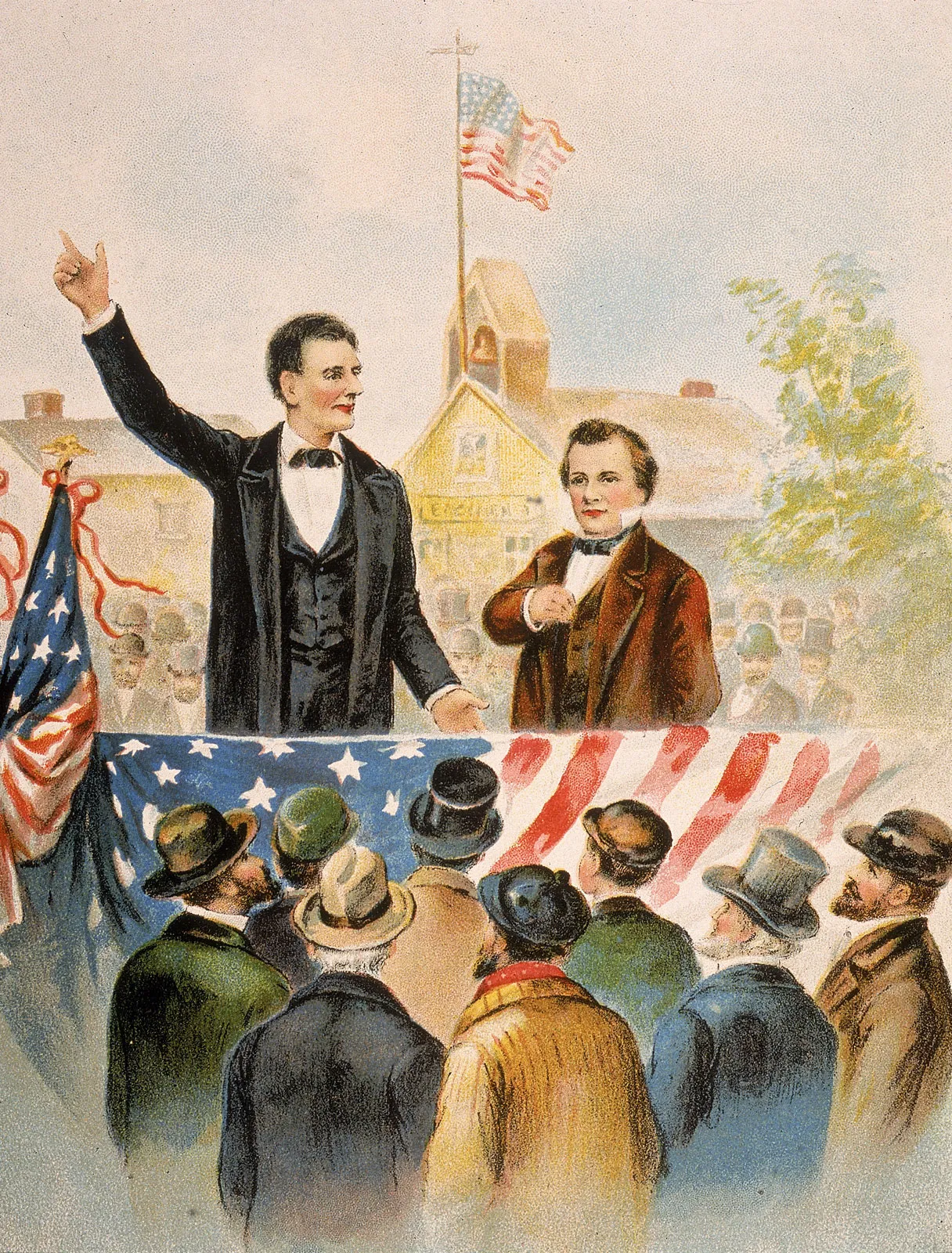
What was John Brown’s Raid on Harper’s Ferry? What did John Brown believe and want to inspire? Significance of Harper’s Ferry Did a slave uprising end up working? What happened to Brown? How did abolitionists vs Southern planters feel about this?
In 1859, militant radical abolitionist John Brown, who wanted complete racial equality, attacked the federal arsenal at Harpers Ferry, Virginia.
Believed in direct action
wanted to inspire a slave uprising by capturing the arsenal and arming slaves
Harpers Ferry was one of the largest warehouse and factories for guns
No uprising ended up happening, as Brown and his rebels were trapped in the arsenal, under siege and surrounded by state militia and US marines
After Brown’s execution, abolitionists hailed him as a martyr for emancipation
Southern planters were outraged and panicked by Brown’s insane raid.
Escalated sectional tensions just before Election of 1860
